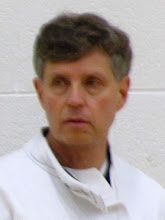When I was a child we used to play a simple game in a friend’s expansive, shadowy basement. Each of us would take turns hiding something in plain sight. Some of us had a gift for it, some didn’t. It was spooky, dramatic and great fun. I remember the thrill of hunting through shelves and trunks and oddly stacked furniture.
The frisson that Lynn and I
experienced when we first came across the Greenwich Foot Tunnel, which crosses beneath
the Thames, was similar. The long tunnel
has its own dreary, Victorian beauty and almost abstract geometry, of
course. But it’s equally fun that in a
sense it’s hidden in plain sight. It
remains a commonly used footpath for crossing the river and the entrances on
either side aren’t that interesting.
A different example is in Chaco
Canyon. If you don’t know much about the
area or even if you do and it’s your first time, you’re naturally drawn to the
monumental great houses built by the Chacoans a thousand years ago. It’s entirely possible to pass by the immense
butte in the center of the canyon thinking it’s interesting, dramatic geography
but no more. In fact Fajada Butte is as
worthy of attention as the more ostensible remnants of Chacoan
construction. The remains of a
95-meter-high, 230-meter-long ramp is hidden in plain sight on the southwestern
face. And, if you have an eye for
detail, you can see remnants of construction near the top. In fact it’s a diverse archaeological site; evidence
suggests it may have been used for religious and ceremonial purposes as well as
astronomical and solar observation. So
Mayan pyramids immediately come to mind:
did the Chacoans use a natural feature instead of a constructed one for
the same purpose? What relationship, if
any, did Mayan culture have to Chacoan culture which came shortly after? And it’s in plain sight.
Here’s something new in plain
sight. Twenty-five years ago I read a
Computer Science paper of which I can find no record. I believe the authors were David C. Evans and
Micky Mantle and the title was something like “Once More Around the Wheel of
Reincarnation.” The point of the article
was that as digital technology and research advance, old architectures are
reinvented and applied to meet the exigencies and opportunities implicit in new
elements. Their particular example was the
computer workstation (which was then in the ascendant) and the mainframe
computer. Since then the architectural
balance between those elements and the elements themselves have been “reincarnated”
many times. Today we have tablet computers
and multiple clouds.
Another technological idea which
recurs and is reapplied is that idea of creating a single and/or preeminent portal
for accessing entertainment, or purchasing hard goods or even consolidating
scientific and technological research.
Amazon clearly demonstrates how successful that strategy can be while
Spotify and even Youtube are more ambiguous in spite of their ubiquity.
In that context, I find
Shakespeare’s Globe’s recent decision to stream their productions of
Shakespeare’s plays very provocative.
The key question is why aren’t they doing it through one of the much
larger portals? The obvious answer is
that they don’t need to. And, if they
don’t need to, others don’t either. It
could be that contrary to the expectation that digital content will continue to
be consolidated, the wheel of reincarnation may be turning to a phase of
dramatic decentralization and distribution.
Perhaps content provision and curation may become entirely separate as
it’s necessarily a compromised relationship anyway. I’m aware of at least one new technology start-up,
The Hawaii Project, which is consistent with that technology culture change.
Around 1150 Chaco was abandoned and the culture that dominated the Colorado Plateau decentralized. Perhaps the image of the Crab Nebula super nova hidden in plain sight on the path to Peñasco Blanco in Chaco Canyon was interpreted as a prophesy of that event.





1 comment:
Thomas, this is really interesting. I had no idea about the ramp at Fajada Butte. We'll have to go by there and take a look one of these days.
I believe high quality content is fragmenting wildly - the proliferation of new forms of media - Twitter, Medium, Instagram ad nauseum - makes it hard to keep up with interesting content and individually produced content is overwhelming the "traditional" media. I think the role of the curator is therefore on the rise, both formal curators (e.g. say someone like Ryan Holiday (http://ryanholiday.net/) or informal curators, like your friend who's always on the lookout for that cool new piece of music they know you'll love.
Now, if someone could crack both high quality curation as well as a scalable personalization scheme, well then they'd have something....and no surprise, that's what we're trying to do with The Hawaii Project.
Post a Comment